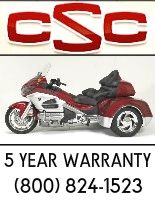Deadeye's report of a failed battery brought to mind an experience a riding buddy and I had last year on the Labor Day Weekend.
We were at the north end of Yellowstone, planning to enjoy new routes to Phoenix when the alternator on his Gl1800 quit and his battery died. Being a holiday weekend and the complexities of using towing services within/outside the park we decided to put the battery from my 2012 Gl1800 into his bike and his dead battery into mine. (Having the same model of bike made this a no-brainer). We then disconnected all of the power using sources on his bike and used my recently purchased booster cables to jump start my bike.
I don't recall the mileage from Yellowstone to Maricopa (30 minutes south of Phoenix) but we certainly swapped batteries many times to get us there. On average, a charge would last about 45 minutes and then it was time to switch, jump start and off we went again. The weather had settled into a steady weekend rain so we got to hone our battery switching skills under less than ideal conditions, as a matter of fact the rain prompted us to refine our technique considerably!
I'm rather amazed that I didn't do some serious damage to my battery, but I've put on 10,000 miles since then and everything continues to run well.
Being equipped to help out a stranded fellow biker is a good thing and when a set of booster cables can be had for less than 20.00 it's also an inexpensive thing!




We were at the north end of Yellowstone, planning to enjoy new routes to Phoenix when the alternator on his Gl1800 quit and his battery died. Being a holiday weekend and the complexities of using towing services within/outside the park we decided to put the battery from my 2012 Gl1800 into his bike and his dead battery into mine. (Having the same model of bike made this a no-brainer). We then disconnected all of the power using sources on his bike and used my recently purchased booster cables to jump start my bike.
I don't recall the mileage from Yellowstone to Maricopa (30 minutes south of Phoenix) but we certainly swapped batteries many times to get us there. On average, a charge would last about 45 minutes and then it was time to switch, jump start and off we went again. The weather had settled into a steady weekend rain so we got to hone our battery switching skills under less than ideal conditions, as a matter of fact the rain prompted us to refine our technique considerably!
I'm rather amazed that I didn't do some serious damage to my battery, but I've put on 10,000 miles since then and everything continues to run well.
Being equipped to help out a stranded fellow biker is a good thing and when a set of booster cables can be had for less than 20.00 it's also an inexpensive thing!






